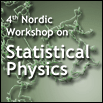Speaker
Dr
Sahin Buyukdagli
(Aalto University School of Science)
Description
Water mediated electrostatic interactions between charged
macromolecules and ions are omnipresent in various
nanoscale systems. From the charge selectivity of ionic
channels in cells and artificial nanofiltration membranes to
the energy storage ability of supercapacitors, these
interactions are at the heart of many biological and industrial
processes. An accurate formulation of electrostatics is thus
necessary to understand the functioning of these
systems, and also for the conception of new generation
nanoscale devices with optimized efficiency. However, for
several decades, the theoretical understanding of
electrostatic interactions has been limited to dielectric
continuum models such as the Poisson-Boltzmann (PB)
formalism that bypass the charge structure of the water
solvent. The talk will focus on newly developed theoretical
approaches that aims at overcoming this limitation by
incorporating the charge structure of solvent molecules into
the current formulation of electrostatics.
In the first part of the talk, I will introduce the key
electrostatic forces that are in play in nanoscale systems,
and explain the modeling of these forces within the
classical formulation of electrostatics. Then, I will
outline the main drawbacks of the classical PB approach and
present a more general dipolar PB (DPB) approach that
considers the solvent molecules on the same footing as the
ions [1,2]. Being a MF theory that models the solvent
molecules as point dipoles, this extended approach neglects
both electrostatic correlation effects and the non-local
dielectric response of water. The remaining part of the talk
will focus on improved formulations that overcome these two
limitations.
The second part of the talk will be devoted to an extended
DPB (EDPB) formalism, still based on the point dipole
approximation, but able to account for electrostatic
correlations beyond the MF level of approximation [3]. This
new approach is particularly adequate for predicting the
energy storage ability of carbon based supercapacitors,
which are efficient nanoscale devices where electrostatic
interactions bring the most important contribution to the
structure of the double layer in the neighborhood of the
electrode surface. I will show that unlike the PB and
DPB approaches that largely overestimate the experimental
differential capacitance data, the EDPB formalism
that can account for the surface polarization effects driven
by electrostatic correlations exhibits a good agreement
with experimental capacitance data of carbon based
materials, thus correcting the predictions of the previous MF
theories by one order of magnitude.
I will present in the third part of the talk a microscopic
reformulation of non-local electrostatics that goes beyond
the point-dipole approximation. By explicitly accounting for
the discrete charge composition of solvent molecules,
the microscopic polar liquid model embodies for the first
time non-local electrostatic interactions at the molecular
level of precision. I will show that unlike the previous DPB
and EDPB formalisms that yields a local picture
of solvent partition at charged surfaces, the new formalism
is able to reproduce several characteristics of the
interfacial non-local dielectric response behavior of water
solvent revealed in Molecular Dynamics simulations [4]
and Atomic Force experiments [5]. Within the same
theoretical framework, I will discuss the hydration induced
modification of the bare ionic polarizability, which is
believed to be the most important ion specific effect on
the interfacial behavior of inhomogeneous electroltyes. I
will conclude by presenting a brief summary of open
questions in the theoretical modeling of polar liquids.
[1] Rob D. Coalson, A. Duncan and N. B. Tal, J. Phys. Chem.
100, 2612 (1996).
[2] A. Abrashkin, D. Andelman, and H. Orland, Phys. Rev.
Lett. 99, 077801 (2007).
[3] S. Buyukdagli and T. Ala-Nissila, Europhys. Lett. 98,
60003 (2012).
[4] O. Teschke, G. Ceotto, and E. F. de Souza, Phys. Rev. E
64, 011605 (2001).
[5] V. Ballenegger and J.-P. Hansen, J. Chem. Phys. 122,
114711 (2005).

